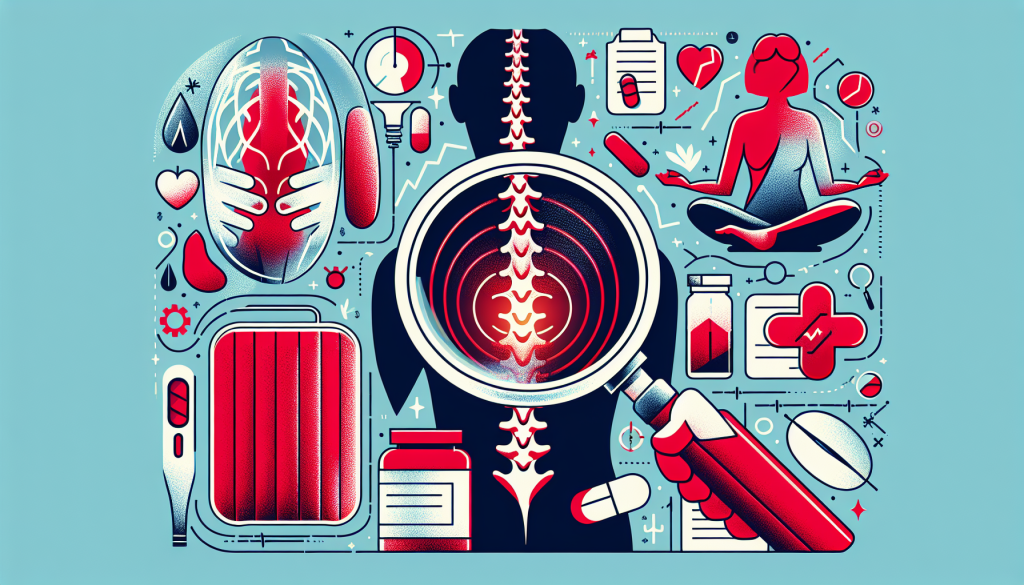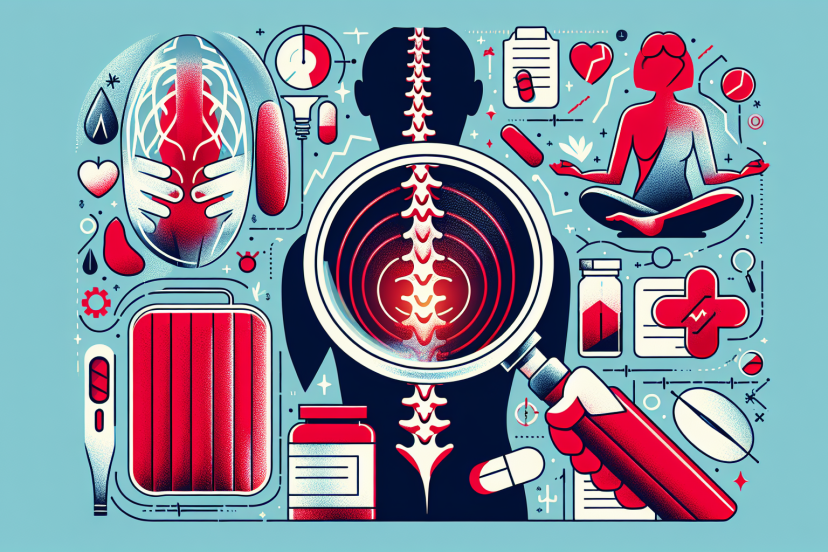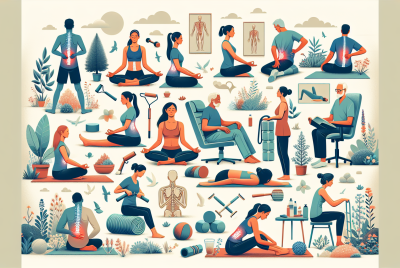10 The Best Back Pain Relief Aid For Your Needs
Are you tired of living with constant back pain? If so, you’re not alone. Back pain is a common issue that affects millions of people worldwide, but finding the right relief aid can be a daunting task. In this article, we will guide you through the process of choosing the best back pain relief aid for your specific needs. Whether you’re looking for a natural remedy or a medical intervention, we’ve got you covered. Say goodbye to discomfort and hello to a pain-free life!
Choose The Best Back Pain Relief Aid For Your Needs
1. Understanding Back Pain
Back pain is a common issue that affects millions of people worldwide. It can range from mild discomfort to debilitating pain, and understanding its causes, types, and symptoms is crucial for finding effective relief.
Causes of back pain
Back pain can be caused by a variety of factors, including muscle strains, ligament sprains, herniated discs, and spinal abnormalities. Other common causes include poor posture, sedentary lifestyle, obesity, and improper lifting techniques. Identifying the underlying cause of your back pain is important for determining the most appropriate treatment.
Types of back pain
There are different types of back pain that can occur in various areas of the back. Upper back pain may be caused by muscle tension or poor posture, while lower back pain is often associated with muscle strains, herniated discs, or spinal conditions like sciatica. Understanding the specific type of back pain you are experiencing can aid in finding targeted relief.
Symptoms of back pain
Back pain can manifest in different ways, with symptoms ranging from dull aches and muscle stiffness to sharp, shooting pains. Additionally, individuals may experience limited flexibility, difficulty standing or sitting for prolonged periods, and radiating pain that extends to the legs. Recognizing the specific symptoms associated with your back pain can help in determining the most suitable treatment approach.
2. Consulting a Healthcare Professional
While many cases of back pain can be managed with self-care measures, it is important to consult a healthcare professional when certain situations arise.
When to seek medical advice
It is advisable to seek medical advice if you experience severe or worsening pain, pain that lasts more than a few weeks, or if you have any accompanying symptoms such as numbness, weakness, or difficulty controlling your bladder or bowels. Additionally, individuals with a history of back injuries or conditions should consult a healthcare professional for proper evaluation and guidance.
What to expect during a consultation
During a consultation, a healthcare professional will assess your medical history, conduct a physical examination, and may order diagnostic tests such as X-rays or MRI scans to determine the cause of your back pain. They will then provide recommendations for treatment options based on their findings.
Questions to ask your healthcare professional
To make the most of your consultation, it is important to ask your healthcare professional questions that will help you better understand your condition and the recommended treatment. Some questions to consider asking include:
- What is the likely cause of my back pain?
- Are there any tests I need to undergo to confirm the diagnosis?
- What treatment options do you recommend and why?
- Are there any potential side effects or risks associated with the recommended treatment?
- Are there any lifestyle changes I can make to alleviate my back pain?

3. Non-Medicated Back Pain Relief Aids
In addition to medical intervention, there are various non-medicated relief aids that can help alleviate back pain.
Heat therapy
Heat therapy, such as applying a heating pad or warm towel to the affected area, can help relax muscles and improve blood circulation, providing temporary relief from back pain. It is important to follow safety guidelines and avoid prolonged exposure to excessive heat to prevent burns.
Cold therapy
Cold therapy, using ice packs or cold compresses, can help reduce inflammation and numb the area, providing temporary pain relief. Applying cold therapy for short durations at a time, with breaks in between, is recommended to prevent skin damage.
Topical creams and ointments
Topical creams and ointments containing ingredients such as menthol, capsaicin, or salicylates can provide localized relief by numbing the area, reducing inflammation, or increasing blood flow. It is important to carefully read and follow the instructions on the product packaging to ensure safe and effective use.
4. Over-the-Counter Pain Relief Medications
Over-the-counter (OTC) pain relievers can be helpful in managing back pain when used as directed.
Types of pain relievers available
Common OTC pain relievers for back pain include nonsteroidal anti-inflammatory drugs (NSAIDs) such as ibuprofen and naproxen sodium, as well as acetaminophen. NSAIDs help reduce inflammation and pain, while acetaminophen works as a pain reliever but does not have anti-inflammatory properties.
Choosing the right medication for your back pain
When selecting an OTC pain reliever, consider factors such as the severity of your pain, any underlying health conditions or allergies you may have, and whether you are taking any other medications. It is always recommended to consult a healthcare professional or pharmacist for personalized advice on choosing the most suitable medication for your specific situation.

5. Prescription Pain Relief Medications
In cases of severe or chronic back pain, prescription medications may be prescribed by a healthcare professional.
Types of prescription medications for back pain
Prescription medications for back pain may include opioid analgesics, muscle relaxants, or anti-seizure medications. Opioid analgesics help manage severe pain but carry a risk of dependence and other side effects. Muscle relaxants can help relieve muscle spasms, while anti-seizure medications can be effective for nerve-related pain.
Risks and benefits of using prescription medications
It is important to discuss the risks and benefits of prescription medications with your healthcare professional. While these medications can provide significant pain relief, they may also have potential side effects, interactions with other medications, or risks of addiction. It is crucial to follow your healthcare professional’s instructions and monitor your response to the medication closely.
6. Physical Therapy and Rehabilitation
Physical therapy can play a significant role in the management and rehabilitation of back pain.
Benefits of physical therapy for back pain
Physical therapy aims to improve strength, flexibility, and mobility while reducing pain and preventing future injuries. A skilled physical therapist will design a personalized treatment plan that may include exercises, manual therapy, electrical stimulation, or other techniques to address the underlying causes of your back pain and help you regain function.
Choosing the right physical therapist
When seeking physical therapy for back pain, it is important to choose a licensed and experienced physical therapist who specializes in orthopedic or musculoskeletal conditions. Ask your healthcare professional for recommendations or do research to find a reputable physical therapy clinic in your area. Additionally, it is important to feel comfortable and have good communication with your physical therapist to ensure a productive therapeutic relationship.
7. Alternative Therapies
Alternative therapies can provide additional options for managing and relieving back pain.
Acupuncture
Acupuncture involves the insertion of thin needles into specific points on the body to stimulate energy flow and promote natural healing. Some individuals find that acupuncture sessions can effectively reduce back pain and promote overall well-being. It is important to seek treatment from a licensed and experienced acupuncturist.
Chiropractic care
Chiropractic care focuses on the alignment of the spine and musculoskeletal system to promote proper functioning and alleviate pain. Chiropractors use manual manipulation techniques to restore spinal alignment and relieve pressure on nerves. Choosing a licensed and reputable chiropractor is essential for safe and effective treatment.
Massage therapy
Massage therapy involves the manipulation of soft tissues to improve circulation, reduce muscle tension, and promote relaxation. Different massage techniques, such as Swedish massage or deep tissue massage, can be beneficial for relieving back pain. Look for a licensed massage therapist with experience in treating back pain.
Yoga and Pilates
Yoga and Pilates are forms of exercise that can improve strength, flexibility, and posture while promoting relaxation and stress reduction. Participating in regular yoga or Pilates classes, under the guidance of an experienced instructor, can help alleviate back pain and improve overall physical well-being.
8. Ergonomic Improvements
Making ergonomic improvements to your workspace and daily activities can help alleviate and prevent back pain.
Evaluating your workspace
Assess your workspace, whether it be an office desk or home setup, and make adjustments to ensure proper ergonomics. Consider factors such as chair height and support, desk height and layout, computer monitor position, and keyboard and mouse positioning. Aim for a neutral, comfortable posture that supports your back and minimizes strain.
Choosing the right ergonomic products
Investing in ergonomic products, such as an adjustable chair with lumbar support, an ergonomic keyboard and mouse, or a standing desk, can provide additional support and help promote proper posture. Consult with an ergonomic specialist or do research to find products that are suitable for your needs and budget.
9. Lifestyle Changes for Back Pain Relief
Incorporating certain lifestyle changes into your routine can contribute to long-term back pain relief.
Exercise and stretching
Engaging in regular exercise, such as walking, swimming, or cycling, can help strengthen the muscles surrounding the spine and improve flexibility. Additionally, incorporating stretching exercises that target the back, such as cat-cow stretches or knee-to-chest stretches, can help relieve muscle tension and reduce back pain.
Maintaining a healthy weight
Excess weight puts additional stress on the spine, contributing to back pain. Maintaining a healthy weight through a balanced diet and regular exercise can help alleviate strain on the back and promote overall well-being.
Improving posture
Practicing good posture throughout the day, whether sitting, standing, or walking, can help distribute weight evenly and reduce strain on the back. Avoid slouching or hunching over and make a conscious effort to maintain proper alignment.
Getting enough sleep
Adequate sleep is essential for overall health and can contribute to back pain relief. Ensure that your sleep environment is comfortable and supportive, with a mattress and pillow that properly align the spine. Practice good sleep hygiene by establishing a regular sleep schedule and creating a calm and relaxing bedtime routine.
10. Surgical Options for Back Pain
In some cases, surgery may be necessary to alleviate severe or chronic back pain that does not respond to conservative treatments.
When surgery might be necessary
Surgery is typically considered when conservative treatments have been unsuccessful or when there is a structural issue in the spine requiring correction. Conditions that might warrant surgery include herniated discs, spinal stenosis, or certain spinal abnormalities. A healthcare professional will thoroughly evaluate your condition and determine if surgery is the appropriate course of action.
Types of back surgery options
There are various types of back surgery procedures, including discectomy, laminectomy, spinal fusion, and artificial disc replacement. The specific procedure recommended will depend on the underlying cause and severity of your back pain. It is important to thoroughly discuss the risks, benefits, and expected outcomes of the surgery with your healthcare professional to make an informed decision.
In conclusion, understanding the causes, types, and symptoms of back pain is essential for finding the most appropriate relief aid. Consulting a healthcare professional, considering non-medicated and medicated options, exploring alternative therapies, making ergonomic improvements, adopting lifestyle changes, and considering surgery when necessary are all potential pathways to achieving back pain relief. Remember to consult with a healthcare professional to find the best approach for your individual needs and circumstances.




